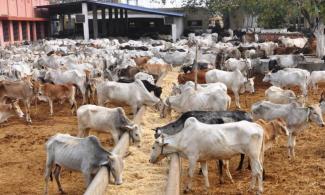
The farmer-herder conflict in Nigeria is an issue of growing concern among stakeholders across the country. These lingering clashes, which have claimed several lives and displaced many others, have forced the government to start thinking of initiatives to address the situation.
The farmer-herder conflict in Nigeria is an issue of growing concern among stakeholders across the country. These lingering clashes, which have claimed several lives and displaced many others, have forced the government to start thinking of initiatives to address the situation.
A 2018 report by Reliefweb said violence between Nigerian herders and farmers had escalated, killing more than 1,300 people since January of the same year. The figures are believed to have increased since then as the media is now awash with daily reports of deaths arising from such clashes.

For Benue State alone, it is estimated that over 2,000 people have been killed and over 1.5 million people are in Internally Displaced Persons' (IDP) camps in the state, following the sustained clashes between farmers and herders between 2017 and 2021.
The farmer-herder conflict is said to have contributed largely to the displacement of millions of Nigerians in the central, north-central, and northwest regions of the country. A recent report by the Internal Displacement Monitoring Center says IDPs across the country are 2,730,000 though not all are attributed to the herder-farmer conflict. It is also said to have sharpened ethnic, regional, and religious polarisation.
In a bid to curb this menace, President Muhammadu Buhari recently ordered a committee to review 368 grazing sites across 25 states in the country to determine the levels of encroachment but this was met with stiff resistance in some parts of the country.
While explaining the situation, the Governor of Kebbi State, Atiku Badugu, said some countries of the world have ranches that are bigger than some states in Nigeria. He made the statement when he appeared as a guest on Channels Television.
Bagudu, who was speaking on the persistent issues of farmer-herder conflict in Nigeria, said mapping out grazing routes will help to identify the scale of the crisis.
He said the president’s directive does not preclude the idea of ranching.
He was quoted as saying, “The committee is to identify grazing routes and work with states and map them. It is not to recover grazing routes, it is to identify the scale of the problem.”
“Mr President is interested in an audit of grazing reserves. It is a voluntary and collaborative thing with the states. People say we have spoken about ranching. Yes, but what is a ranch? Ranching does not take place in the air, it takes place on a piece of land.
“Ranches are as big as grazing reserves. In some countries like Australia, some ranches are bigger than some Nigerian states.
“So how do you know what’s available, what can be supported to host those roving, herding communities who need help to modernise?”
Claim: The Governor of Kebbi State, Atiku Badugu, said some countries have ranches that are bigger than some states in Nigeria.
Verdict: The governor's claim is true. Some ranches are as big as 24, 000km² in Australia– which is far bigger than Lagos that is 3,671km² big, and some other Nigerian states.
Verification
Dubawa ran a check on the landmass of Nigeria as a whole. According to the World Bank collection of development indicators, land area (sq. km) in Nigeria was reported at 910,770 sq. km in 2018.
Meanwhile, the Nigerian High Commission, UK specified that the Area Total was 923,770 km2 while the Area Land was 910,770 with a coastline of 853 km.
The country is divided into 36 states of the federation with the least (in terms of landmass) being Lagos at 3,671km² followed by Anambra at 4,865 km²; Abia State, 4,900 km²; and Imo State, 5,288 km².
Some others are as follows: Ekiti: 5,435km²; Ebonyi: 6,400km²; Akwa Ibom: 6,900km² while 12 other states of the federation are within 7, 534km² and 23, 561km².
The report quoted the Nigerian Meteorological Agency (NIMET).

Dubawa researched further and discovered that one of the cattle ranches (station) in Australia, referred to as the world’s biggest cattle ranch, Anna Creek Station, covers 23,677 square kilometres (9,142 square miles) of arid central Australia.
From further research, it was discovered that Clifton Hills is considered to be the world's second-largest farming property with more than 16,500 square kilometres.
Australia has been said to be the world's third-largest exporter of beef - selling more than 1.5 million tonnes a year of red meat - according to the U.S. Department of Agriculture.
The country is recognised as a leading long-haul exporter of live cattle globally, with trade links to supply chains in South-East Asia and the Middle East, although a report said Australia produces only 4% of global beef.
Conclusion
There are ranches in some countries of the world that are larger than some states in Nigeria as claimed by Bagudu.
The researcher, Elizabeth Ogunbamowo, produced this fact-check per the Dubawa 2021 Kwame KariKari Fellowship in partnership with SaharaReporters to facilitate the ethos of “truth” in journalism and enhance media literacy in the country.